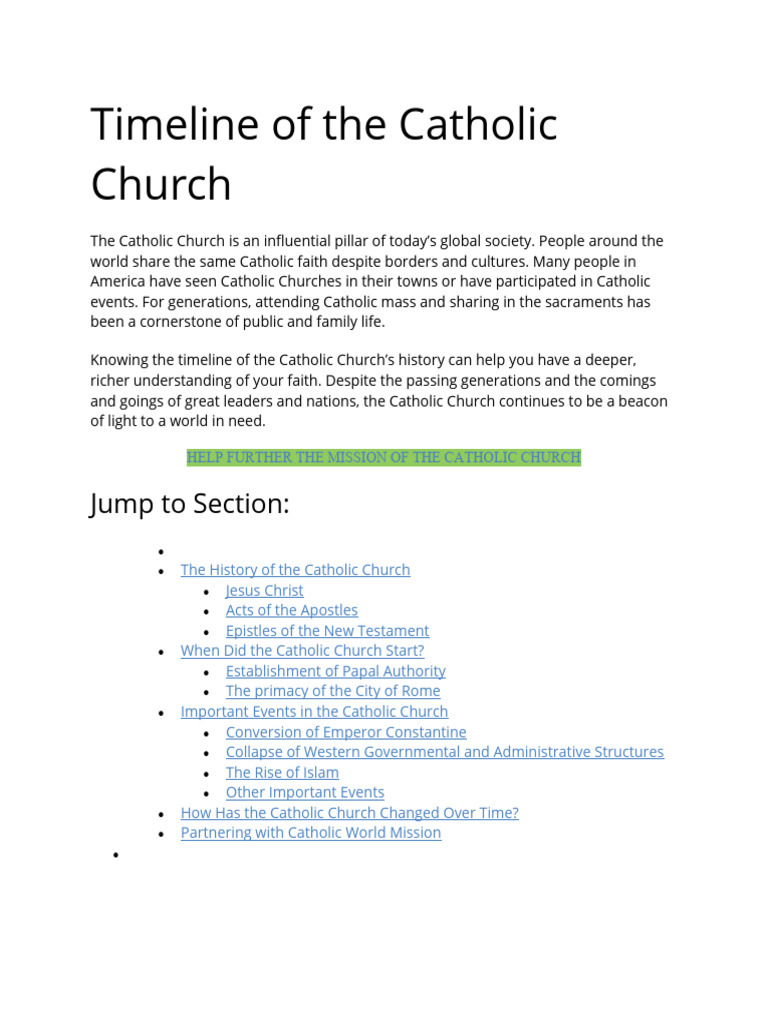When contemplating the establishment of the Catholic Church, one might whimsically ask: “Did it spring forth fully formed like Athena from the brow of Zeus, or was it a gradual evolution, shaped by historical currents and theological debates?” This question not only invites curiosity but also challenges preconceived notions about the origins of one of the world’s oldest religious institutions. To delve into this complex history, we must traverse various epochs, scrutinizing key milestones that contribute to the understanding of the Catholic Church’s genesis.
To begin with, the roots of the Catholic Church are enshrined in the life and teachings of Jesus Christ, whose ministry commenced around AD 30. The foundational event is commonly situated in Jerusalem, where Jesus, a Jewish preacher, proclaimed the Kingdom of God. His crucifixion circa AD 33 and subsequent resurrection, as recorded in the canonical gospels, set in motion a fervent movement among His followers. These individuals, primarily Jewish, initially engaged in communal worship and shared teachings, which laid the groundwork for early Christianity.
Post-resurrection, the apostles, particularly Peter and Paul, became pivotal figures in this nascent community. Around AD 35-50, Paul’s missionary journeys expanded the reach of Christian doctrine throughout the Roman Empire. This expansion was not merely geographical but also cultural, as it prompted the inclusion of Gentiles (non-Jews) into the fold. The implications of such inclusivity were profound, challenging existing paradigms of worship and community identity.
By the mid-first century, the fledgling community began to develop organizational structures. The appointment of bishops in major cities, such as Rome, Antioch, and Alexandria, established a semblance of hierarchy. However, a central query during this time was: What constituted authentic teaching? The emergence of various heretical movements, such as Gnosticism, led to the need for orthodoxy. This necessitated the formation of creeds and councils, aimed at solidifying doctrine and maintaining unity.
The year 70 AD marked a cataclysmic event with the destruction of the Second Temple in Jerusalem. This pivotal moment catalyzed the dispersion of early Christians and intensified the distinct identity of Christianity vis-à-vis Judaism. The development of texts, particularly the letters of Paul and the gospels, became crucial in shaping the beliefs and practices of this burgeoning faith.
The first major external challenge to the Church arose during the reign of Emperor Nero (AD 54-68), who infamously persecuted Christians, blaming them for the Great Fire of Rome in AD 64. Despite or perhaps because of this persecution, the faith continued to proliferate among diverse populations, signaling resilience in the face of adversity.
Fast forward to the fourth century, a significant turning point materialized with the Edict of Milan in AD 313, issued by Emperor Constantine. This decree granted religious tolerance towards Christians, signaling a shift in the socio-political landscape. The subsequent Council of Nicaea in AD 325 further illustrates this evolution, as it sought to address theological disputes, notably the nature of Christ, thereby reinforcing a unified doctrine that solidified the Church’s claims to authority.
The fifth century continued to witness critical developments, including the waning of the Western Roman Empire and the concurrent rise of papal authority in Rome. Popes began to emerge as spiritual leaders, claiming apostolic succession from St. Peter. This period also heralded the establishment of distinct Christian practices, rituals, and the veneration of saints, elements that would encapsulate the Catholic experience.
The Middle Ages brought about a fusion of faith and governance, particularly through the influence of monastic orders such as the Benedictines and Franciscans. The Church became a formidable political entity, entwined with the socio-economic fabric of Europe. One must ponder: How did this intertwining of faith and power shape the moral authority of the Church? As the ecclesiastical hierarchy solidified, so too did challenges from emerging reformist movements.
Fast forward to the 16th century, a seismic shift occurred with the Protestant Reformation. Figures such as Martin Luther and John Calvin vehemently critiqued Church doctrines, leading to a fracturing of Christian unity. The Catholic Counter-Reformation sought to address these critiques, reaffirming core tenets of the faith while also initiating internal reforms. This period is vital in understanding how the Catholic Church adapted to historical and societal changes.
As the timeline progresses into the 19th and 20th centuries, the Catholic Church found itself grappling with modernity. The industrial revolution, coupled with global conflicts, prompted a re-examination of its role in society. Vatican II (1962-1965) epitomizes this re-evaluation, encouraging engagement with contemporary issues and fostering interreligious dialogue, an evolution that resonates with the Church’s emphasis on teaching and compassion.
The inquiry into when the Catholic Church was established is thus an intricate tapestry woven from myriad threads of history, theology, and sociopolitical dynamics. From its inception in the first century to its present standing as a diverse global institution, the Church’s journey reflects adaptability amidst enduring principles. In pondering this timeline, one may discern that what began as a small assembly in a Roman province evolved into a formidable institution with a profound impact on billions worldwide. The question, however, remains: is this evolutionary process complete, or does the Church continue to transform amid the challenges of the contemporary world?



